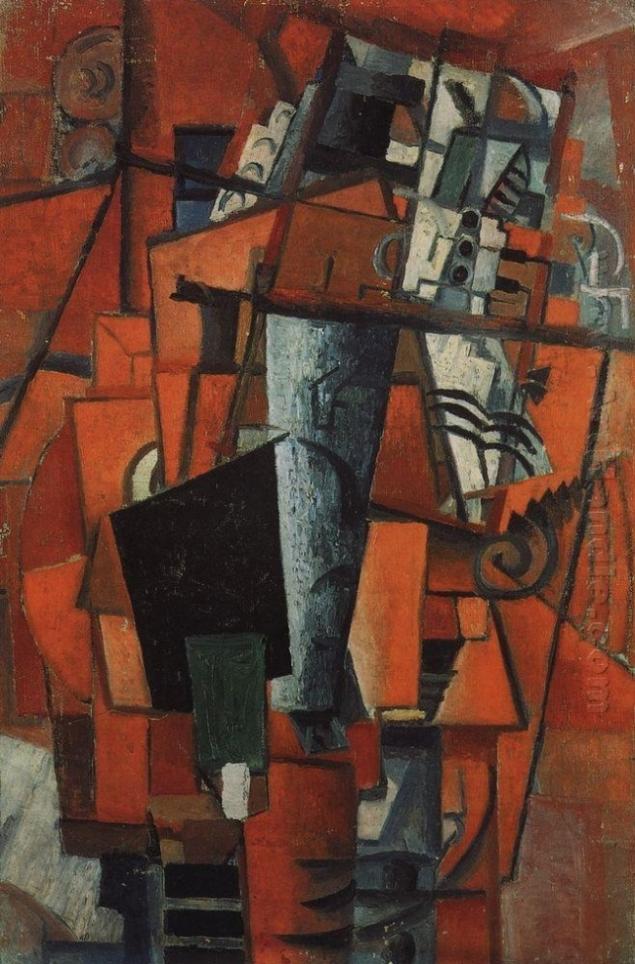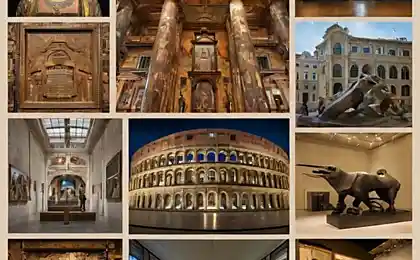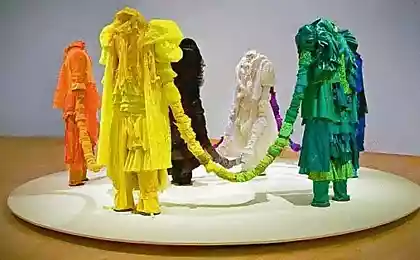234
11 facts about famous museums that you did not know

= Partner post Website and Sberbank =
Have you noticed that a subject with a history is much more valuable than a subject without a history? For example, there is just tea, and there is tea collected by unmarried girls. Or here's an ordinary white dress, which is a lot in any women's store. But it sells for $4.6 million. The plissed skirt of this particular dress soars up on Marilyn Monroe in the movie "Seven Year Itch." Let’s go further: Rembrandt’s painting “Danaia”. In 1985, a mentally ill man doused the painting with acid. It has been restored for over 20 years. And now it can only be seen through a thick layer of protective glass. When a subject has a story that reaches for it like a plume, the attitude towards it becomes more reverent and attentive.
Find out 11 more fascinating stories about museums and their exhibits. And visit these museums for free: this fall, Sberbank in honor of its 175th anniversary gives everyone this opportunity. Read more at sberbank175.afisha.ru
1. Museum of Fine Arts
them. A. S. Pushkina, Moscow

Patron Yuri Nechaev-Maltsov invested 2 million out of 2.6 million rubles in the construction of the museum. Initially, the patron planned to make columns of the museum from a special frost-resistant white marble, which was mined in the Urals. But then it turned out that it was impossible to make columns of 10-meter length. They decided to order them in Norway. The columns of the museum sailed first by sea on a steamer, and then by barges to Moscow.
Another interesting fact concerns the exhibits. Graphic works exhibited in the museum are shown no more than 3 months. The lighting of these exhibits should not exceed 50 lux. After the exhibition, the works are rested in storage from 6 months to 1 year.
2. Hermitage, St. Petersburg

In the treasury of the Hermitage there are almost 3 million exhibits: paintings, sculptures, graphics, objects of everyday life of emperors, including dining sets. According to one legend, the secretary of the regional committee married his daughter and decided to take from the vaults of the Hermitage a ceremonial gold set for 140 people. At one time it was specially ordered by Empress Catherine II at the porcelain factory of the English merchant Franz Gardner. The gunman, learning about these plans, decided to protect the legacy of the Empress. When they arrived late at night from Smolny for a set, they were met by an armed knight in steel armor, who was threateningly waving a huge sword.
But then there was an unfortunate oversight. One of the service shepherds, which at that time guarded the museum, clinged to the body of the gunner, not protected by armor. The "ghost of the museum" soared with a human voice, and the operation to save the imperial service failed miserably.
3. Russian Museum, St. Petersburg

According to one version, the color of the museum coincides with the color of the gloves of the favorite of the emperor Anna Gagarina (Lopukhina). When the construction of the Mikhailovsky Castle was over, Anna Lopukhina dropped her glove at one of the palace balls. Paul I, trying to be courteous and gallant, was the first to pick it up and return it to the owner. But I noticed its unusual yellow-orange color. After a little thought, the emperor immediately sent it to the architect Vincenzo Brenna as a sample of the future color of the castle.
Did the emperor return the glove or leave it with the architect?
4. State Art Gallery, Perm

The collection was formed both in the traditional way (transfer from the capital’s museums, search for exhibits by expeditions and redemption from the population), and in unusual ways. In 1926, a worker of a locomotive repair plant, whose name has been lost, found in the storerooms of the State Bank (I wonder what he was doing there?) and brought to the gallery “South Landscape” (1866) the St. Petersburg academician-marinist Lev Lagorio.
And the painting “Forest Fire” (1897) by the famous painter Alexei Denisov-Uralsky in 1934 was transferred to the museum by a group of Red Army soldiers passing through Perm. They said the painting had been kept at the headquarters of their unit throughout the Civil War instead of an icon.
5. State Art Gallery
them. P. M. Dogadina, Astrakhan

Once the famous poet-futurist Velimir Khlebnikov, who visited his parents in Astrakhan, in the newspaper “Red warrior” expressed his dream to see in the gallery the works of Russian avant-garde. The words of the poet were prophetic, and the museum gallery was replenished with the works of Kandinsky, Malevich, Chagall and many others. Today the collection of the Russian avant-garde of the Astrakhan Art Gallery is one of the most famous among Russian museums.
6. Art Museum, Yaroslavl

A few years ago, in one of the halls of the museum exposition, there was a French gilded armchair of the XVIII century with the image of flowers. Every day, the caretaker whipped a soft chair cushion. You'd think why? No one has been in the chair for a long time. In the morning, however, this pillow was always crumpled.
The love of sitting in a chair was attributed to Catherine II, whose portrait hung in the same room near the chair. Since then, the caretakers entering the exhibition hall with portraits of the XVIII century, where the largest number of images of the imperial nobility is concentrated, necessarily say: “Good morning, ladies and gentlemen!”
Although the French chair has not been exhibited in this hall for a long time, the habit of greeting the most august people remained.
7. Gallery of Modern Art, Irkutsk

Unlike other museums, this gallery is private and belongs to Viktor Bronstein. It hosts exhibitions of the famous Buryat artist Zorikto Dorzhiev, who created costumes for the films Mongol by Sergei Bodrov, Children of the Sun by Garik Sukachev and Heavenly Wives of Meadow Marys. “I want to create something native and untouched...” – this is how the artist characterizes his principle. Looking at his paintings, we can say that he does it perfectly.
8. Primorsky State Art Gallery, Vladivostok

The exposition of the museum presents “Still Life” by F. Barzenkov (1858, canvas, oil). Admiring this work, it is hard to believe that 10 years it was saved by the skillful hands of restorers. She entered the gallery with 24 gusts on canvas. A huge restoration work was done: breakthroughs were made, the author’s canvas was duplicated into a new one, lost sections of the picturesque layer were restored. And as a reward to the restorers, the author’s signature and the year of the creation of the work were opened.
9. State Art Museum, Novosibirsk

In the exposition of this museum there is a painting with a “secret”. If you carefully look at the work of K. S. Petrov-Vodkin “Kolkhoz Woman on Lake Ilmen”, you can see the outlines of the portrait of A. S. Pushkin. Initially, the artist planned to write a completely different plot on this canvas, but, having changed his mind, he sketched what he had started with a new layer of colors. Therefore, you should go to the museum and see the profile of the poet with your own eyes.
10. Museum of Fine Arts, Kazan

Now the museum is located in the heart of the city, the historical part of Kazan in the former residence of General Sandetsky. In the early twentieth century, the city was built in such a way that the mansion was almost on its outskirts. And so after the revolution, a tubdispensary, a sanitary museum and a malaria station were placed here. And only in 1967, the mansion of General Sandetsky was transferred to the State Museum of Fine Arts of the Republic of Tatarstan.
11. V. I. Surikov Art Museum, Krasnoyarsk

During the transfer of works of art in 1957 from the Krasnoyarsk regional museum of local lore to the art gallery created at that time, an incident occurred, about which I. A. Firer (director of the art school) tells: Zinaida Konstantinovna (director of the local history museum) entered, holding a small picture with two fingers by the corner. In a broad gesture, she threw her to the floor:
- Can you take that, too?
- Take it, I readily replied, picking up the painting from the floor.
It was Malevich, “Lady at the piano” – one of the pearls of today’s collection of the Krasnoyarsk Art Museum.
“Beauty will save the world,” said the famous classic. And this is true, because interest in painting, sculpture, graphics is growing every day. People strive for beauty and to surround themselves with beauty. Sberbank invites you to touch the magnificent works of artists, icon painters and sculptors, which from October 17 to November 30, 2016 generously gives a free visit to each of them.museums. Come with the whole family and learn many other fascinating stories about museums and their exhibits.
Photo at wastesoul preview
via depositphotos.com/? utm_source=Adme&utm_medium=freesub&utm_campaign=RU-brand























